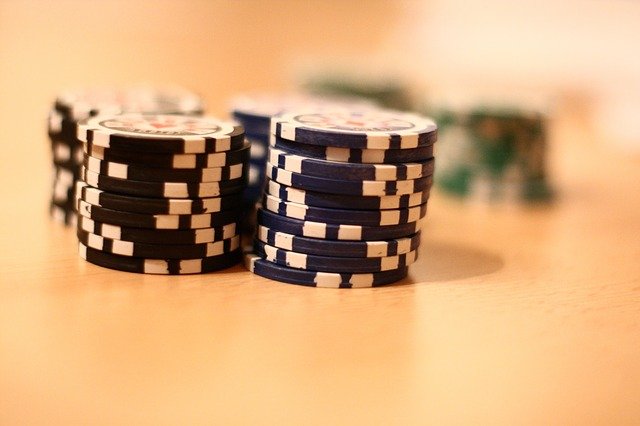3-Betting Is A Very Strong Play In Poker Tournaments,
Our Beginners Guide Explains How To Use This Strategy Correctly
 When someone raises in a poker game and another player re-raises – the intended message is usually loud and clear. Essentially the re-raiser is saying that they have a monster hand and are prepared to play a big pot. This second raise is known as a 3-bet, with the blinds being the first bet and initial raise the 2nd bet. As the game of poker has evolved this ‘massive strength’ message is not necessarily always true – in fact, players will often 3-bet with the intention of looking strong when their hand is actually weak.
When someone raises in a poker game and another player re-raises – the intended message is usually loud and clear. Essentially the re-raiser is saying that they have a monster hand and are prepared to play a big pot. This second raise is known as a 3-bet, with the blinds being the first bet and initial raise the 2nd bet. As the game of poker has evolved this ‘massive strength’ message is not necessarily always true – in fact, players will often 3-bet with the intention of looking strong when their hand is actually weak.
Using 3 bets effectively and defending against 3 bettors is a complex area. In this article I will go through the basics of a solid re-raising strategy for beginning to intermediate players of online poker tournaments – showing some of the key factors to consider before you 3-bet.
First up I will explain why 3-bets are effective and then consider two extremes which show the need for balanced strategy, these are players who only ever re-raise with the very best hands, and those who re-raise too often. This will lead into a discussion on balancing your 3-bet ranges against different types of opponent. Next position at the table is covered, including why there is less advantage in balancing your ranges out of position, or against 'calling station' type opponents. Stack sizes and tournament situations (particularly the bubble) also make a huge difference to your re-raising strategy. I finish by summarizing the key points and pointing you in the direction of some very profitable tournaments!
3-Bets In Online Poker Tournaments – Why These Are Effective
Re-raises look (and often are) very strong. Say a player opens the pot with a 3 big blind raise and an opponent comes up with a 3-bet of 2.5 to 3 times the size of that raise… what can the initial raiser do with various hands he might have raised with?? Let me take an initial raising range of 15% which is not unreasonable for a mid to later position raise and we can have a look:
15% = Pairs 77 or higher, aces down to ace-seven suited or ace-10 unsuited, and many combinations of 2 picture cards.
When someone unknown puts in a big 3 bet they are representing JJ+ (at least) with A-Qs the smallest ace. Now, what could the initial raiser call with (out of position) and play profitably?
Of course this depends on stack sizes (the ability to try and hit trips with a pair when stacks are deep is key). In reality the only hands you might feel comfortable about playing are the very best ones – and if your opponent is willing to build a big pot it makes more sense to 4-bet those and get the money in pre-flop.
3-betting creates a really difficult situation for someone holding a marginal hand, they are forced to 4-bet or fold most of the time, and if they do call then this may just lead to more problems on the flop / turn betting rounds.
Having said this, a danger in lower level poker tournaments is that players are often inexperienced enough to flat call without either a plan or the correct implied odds. Those same players will call all the way to the river too if they have even a medium strength hand – I’ll put this important factor to one side for now, and return to it later in the article, after explaining some more of the 3-bet basics.

3-Betting In Poker Tournaments – Too Tight / Too Loose
Here are some common examples from lower buy-in poker tournaments. Firstly many players only ever re-raise with the very best hands, this can be QQ / AK+ or even KK+ only. Those same players often 3-bet small amounts – even the minimum, which tips off the field that they have a monster at the same time as giving the correct odds for everyone to call with speculative hands which can easily outflop premium holdings.
If this is you then this could very well be a reason your premium hands get cracked a little too often. If you identify a '3-bet nit' then your ideal counter strategy depends on stack sizes, if you have the odds to set-mine (for example) then this can be a very profitable spot!
How about the opposite? Some players re-raise with a huge range, I have seen players regularly do this with 20% + of their range (pairs, most aces and any 2-picture cards for example). This time things are often compounded by making the re-raise too big! This is very easy to exploit by flat calling in position, 4 betting for value with the top of your range. If the loose 3-bettor wants to play easily dominated hands out of position in a big pot you should encourage this – it will take a massive skill advantage for this to be profitable, and this type of player only rarely any advantage at all!
So, 3-betting too tight and 3-betting too often are both easily exploitable in tournament situations. Where is the balance point?
Mark's Tip: If you are not yet at the stage where you can spot the tight 3-bettors from the average or loose players I can recommend Tournament Shark from the Pro Poker Labs, this tool is approved by the major sites - and attaches to your table to let you know who are the good and bad players! See our Best Poker Tools page for more.
3-Betting In Poker Tournaments – Balanced Ranges Are Harder To Play Against
If you re-raise tight you will rarely be able to play big pots with premium hands, too loose and you’ll get 4-bet (or flatted) often – and have to fold those 10 to 12 big blind investments in the pot for the same reason many players will fold to 3-bets!
However, if your range of 3-betting hands is balanced you become very hard to play against. Lets take an easy example and say you 3-bet with the top 3% of hands, say 10-10+ and AK off, and also 3-bet bluff with an additional 3% of speculative hands including tiny pairs and suited connectors (though suited broadways could also be chosen).
By doing this you make it hard for opponents to 4-bet bluff, since you’ll have the goods a lot of the time. Since you are not always raising premiums it will also be a mistake for opponents (in a ‘Theory of Poker’ sense) to fold often to your reraise. What is more you will be playing tight enough to get respect on the flop and take down those extra pots when your opponent does not make a monster.
3-Betting In Online Poker Tournaments – Position, Opponent Types And Getting Flatted!
A constant risk in lower ($20 and under) buy-in poker tournaments is the novice who flat calls too often. I want to look at one particular situation which comes up a lot.
Say a loose early position player raises 3x, you 3-bet to 9x and *boom* a novice on the button flats – the original raiser folds and now you are heads-up in a big pot and first to act… nasty!
If you missed the flop, bet and get called you are in a difficult spot. Made worse by the fact that the type of player who flats in those situations is unlikely to be thinking about what you are representing with your 'strong' bets. They are playing their own cards only and will often not fold with any decent draw or part of the flop whatever the betting.
In this situation a balanced range loses much of its value.
3-betting in early position or from the blinds carries the additional ‘flatting’ risk. In fact if your opponents show a pattern of flatting 3-bets, even when you do have position, the number of your ‘balancing’ hands should go down. If you think you are likely to be flat called then tip the balance back in favor of those premium hands, then build the pot slowly to extract maximum chips from your passive 'cally' opponents.
3-Betting In Poker Tournaments – Stack Sizes And Bubbles
So far the discussion has assumed that players have enough chips for post-flop decisions. In a tournament this will not always be the case. This factor is complicated by the fact that there will often be a range of different stack sizes to play against. In tournament situations the effective stack size (the one we work with for math purposes) is the smallest in the hand.
Here are some situations in which stack sizes might affect your play:
-
Your 3-bet can often commit you to call a 4-bet based on the pot-odds. For example if you start with 25 times the big blind, there is a raise of 3x and you make it 9x, including the blinds and antes there are now 14 blinds total in the pot, your opponent 4-bets (has you covered) and you now face a call of 16 times the big blind to win a pot of 39. That’s more than 2.3 to 1, meaning you only have to win the pot less than 30% of the time to break even! Even if you give your opponent a range of JJ+ for the 4-bet you can still call with the huge number of hands - around 15% in fact - what you have just done is priced yourself into the call.
-
With a stack of around 15 times the blinds, you have a good ‘resteal’ stack and can put pressure on raisers by 3-betting all in. Caution is required if there are several opponents still to act, if someone is aware of stack size dynamics they might overcall with a hand which crushes your looser range - since they know your stack is ideal for 3-betting light!
-
Big stacks at the table might be more inclined to play back, either by flatting or 4-betting a wider range. They have the chips to spare and can put huge pressure on you, particularly if you are 3-betting often. Smaller stacks can also be dangerous, these players might well call out of sheer desperation or needing a double up to have a viable chance of going deeper in the tournament.
Bubbles are great times to 3-bet. This could be the money bubble or the final table bubble. At this point the mid-stacks in the game become easy targets. They have enough chips to ‘play’, yet will not want to risk their comfortable stacks without a really strong hand. This increases the gap between hands they could raise with and hands which could call a 3-bet – and you can use this to your advantage to win some pots! Bear in mind that 4-bet on the bubble from a mid-sized stack can be very strong, you need to be careful!
3-Betting In Poker Tournaments – Summing It Up + Next Steps
Re-raising is a great way to build your chip stack, as long as you are aware of the dangers. My recommendation to newer players is first to ensure that their 3-bets are not ‘premium only’ as this is very easy to exploit. Next focus on position and stack sizes and ensuring that your range is somewhat balanced. Remember, positive and aggressive poker is profitable – as long as you are aware enough to get out of the way when the warning bells start to sound.
Planet Mark’s Rec: America’s Cardroom are crushing it for online poker tournament events that welcome both US and worldwide players. ‘The Venom’ tops the list, alongside OSS events, PKO games and a packed regular schedule with guarantees that are growing all the time.
Best of all, you can get your bankroll off to a flying start with a huge 100% welcome deal using bonus / referral code SNGPLANET.
Check out the latest promos and tournament events for yourself now at www.americascardroom.eu!
More Popular Tournament Strategy Articles:
-
Pre-Flop Poker Tournament Strategy Basics
-
10 Best Beginners Poker Tournaments
-
45 Player SNG Strategy (Great For Building Your Bankroll)
-
ACR Poker (Winning Poker Network) Referral Code


